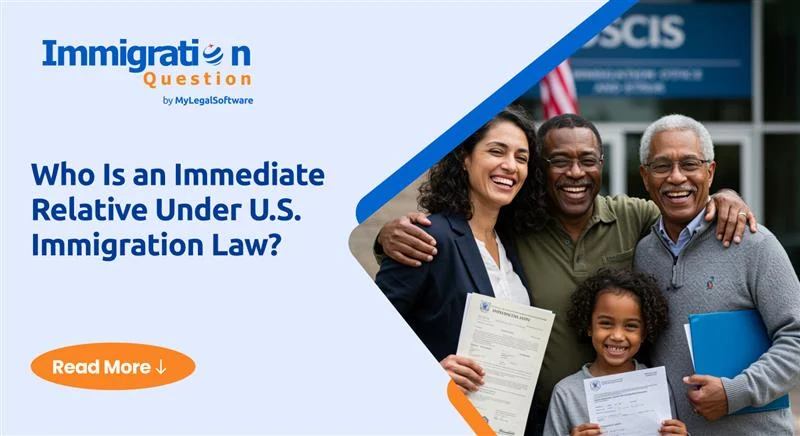In U.S. immigration, family ties can speed up the process of permanent residency. One of the most advantageous family categories is the immediate relative of a U.S. citizen. But who is considered an immediate relative for immigration purposes?
Here is everything you need to know.
Who Is an Immediate Relative?
Under U.S. immigration law, an immediate relative is a classification that comes with a significant benefit: no annual cap on immigrant visas. This means there is no waiting list to apply for a green card under this category, unlike other family-based immigration categories with visa quotas.
According to the U.S. Citizenship and Immigration Services (USCIS), you are considered an immediate relative of a U.S. citizen if you are:
- The spouse of a U.S. citizen
- An unmarried child under the age of 21 of a U.S. citizen
- The parent of a U.S. citizen (if the U.S. citizen is 21 years or older)
Immediate Relatives and Family-Based Immigration
A foreign citizen hoping to live permanently in the U.S. needs an immigrant visa. Family-based immigrant visas require sponsorship by a relative who is a U.S. citizen or a U.S. Lawful Permanent Resident. However, only U.S. citizens can sponsor immediate relatives, and the benefit is significant.
Examples of immediate relative visas are:
- IR1 and CR1 for spouses
- IR2 for children
- IR5 for parents
Unlike other visa categories, these are unlimited; they are always available throughout the year.
What is the Immigration Process for Immediate Relatives?
The sponsoring U.S. citizen must first file Form I-130 (Petition for Alien Relative) with USCIS. Each relative requires a separate petition.
The green card application process will differ depending on whether your family member is already in the U.S. or is applying from abroad.
1. If Your Family Member Is in the U.S.:
Adjustment of Status
If the applicant is already in the United States, they can apply for a green card through Adjustment of Status.
Steps:
- File Form I-485: Apply to adjust status to permanent resident.
- Biometrics Appointment: Attend a scheduled appointment for fingerprints, photos, and a background check.
- Interview: USCIS may call for an interview to confirm details.
- Additional Evidence: You may receive a Request for Evidence (RFE) if more documents are needed.
- Final Decision: USCIS will mail an approval notice and the physical Green Card later.
2. If Your Family Member Is Abroad:
Consular Processing
If the applicant is outside the U.S., the process involves visiting a U.S. embassy or consulate close to them.
Steps:
- File Form I-130: The U.S. citizen sponsor submits the petition.
- Wait for Interview Notification: The consulate will schedule an interview once the visa is available.
- Attend Consular Interview: The officer reviews the application and supporting documents.
- Receive a Visa Packet: If approved, you will receive a visa packet to present at the U.S. port of entry.
- Pay the USCIS Immigrant Fee
- Green Card Arrival: After entering the U.S. and paying the required fee, the Green Card is mailed to your U.S. address.
Why Work with a Lawyer?
The immediate relative category is one of the most efficient ways to obtain a U.S. green card. An experienced attorney can help you navigate the immigration rules, forms, timelines, and eligibility requirements. Visit Immigration Question to get professional legal help.
Get Legal Help with Immigration Question
Immigration Question connects individuals with trusted immigration attorneys who can guide you through the immediate relative visa process and other immigration pathways.
Our network of experienced attorneys can help you explore your immigration opportunities as an immediate relative.
Frequently Asked Questions About Immediate Relatives
1. Who is an immediate relative of a U.S. citizen?
An immediate relative of a U.S. citizen is someone who qualifies for a green card without having to wait for a visa to become available. These include spouses, unmarried children under 21, and parents of a U.S. citizen who is 21 years or older.
These relationships are considered close family ties and receive priority in the immigration process.
2. How long does an immediate relative visa take?
There is no annual cap for immediate relative visas, meaning there is no waiting for a visa number. However, the processing time still depends on factors such as USCIS processing times, background checks, and interview scheduling.
On average, the process can take several months to over a year. However, times vary based on each case and whether the applicant applies through Adjustment of Status or Consular Processing.
3. Can a green card holder file for an immediate relative?
Green card holders can file for their spouses and unmarried children.
4. Which forms are required to sponsor an immediate relative?
The U.S. citizen must file:
- Form I-130 – Petition for Alien Relative
- Form I-485 – Application to Register Permanent Residence (if the relative is already in the U.S.)
5. Where can I get help with my immediate relative visa application?
Immigration Question connects you with experienced immigration lawyers who can guide you through the immediate relative visa application process. Visit Immigration Question to get started.y




![Top 5 Immigration Questions People Asked Online This Week [May 23, 2025]](https://blog.immigrationquestion.com/wp-content/uploads/2025/05/top-5-immigration-questions-people-asked-online-this-week-may-23-2025-768x419.webp)




